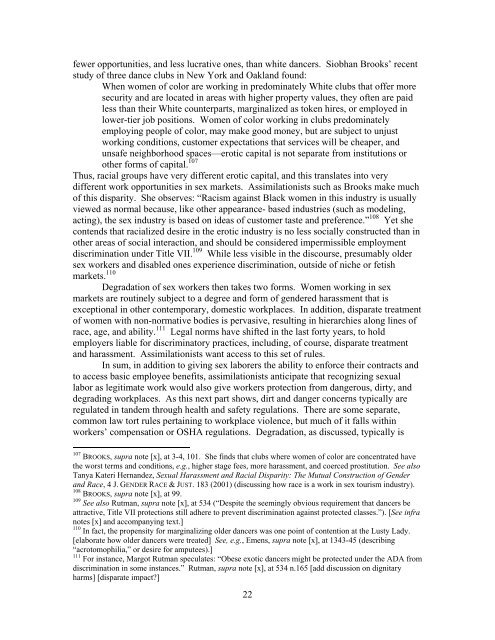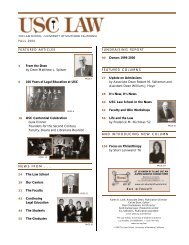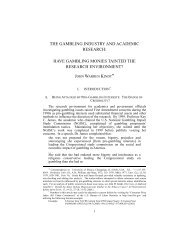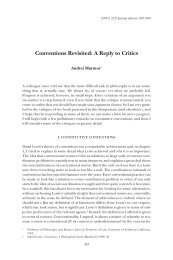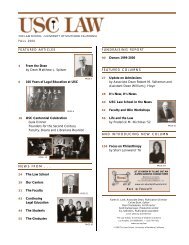1 Regulating Sex Work Adrienne D. Davis VERY ROUGH DRAFT ...
1 Regulating Sex Work Adrienne D. Davis VERY ROUGH DRAFT ...
1 Regulating Sex Work Adrienne D. Davis VERY ROUGH DRAFT ...
Create successful ePaper yourself
Turn your PDF publications into a flip-book with our unique Google optimized e-Paper software.
fewer opportunities, and less lucrative ones, than white dancers. Siobhan Brooks’ recent<br />
study of three dance clubs in New York and Oakland found:<br />
When women of color are working in predominately White clubs that offer more<br />
security and are located in areas with higher property values, they often are paid<br />
less than their White counterparts, marginalized as token hires, or employed in<br />
lower-tier job positions. Women of color working in clubs predominately<br />
employing people of color, may make good money, but are subject to unjust<br />
working conditions, customer expectations that services will be cheaper, and<br />
unsafe neighborhood spaces—erotic capital is not separate from institutions or<br />
other forms of capital. 107<br />
Thus, racial groups have very different erotic capital, and this translates into very<br />
different work opportunities in sex markets. Assimilationists such as Brooks make much<br />
of this disparity. She observes: “Racism against Black women in this industry is usually<br />
viewed as normal because, like other appearance- based industries (such as modeling,<br />
acting), the sex industry is based on ideas of customer taste and preference.” 108 Yet she<br />
contends that racialized desire in the erotic industry is no less socially constructed than in<br />
other areas of social interaction, and should be considered impermissible employment<br />
discrimination under Title VII. 109 While less visible in the discourse, presumably older<br />
sex workers and disabled ones experience discrimination, outside of niche or fetish<br />
markets. 110<br />
Degradation of sex workers then takes two forms. Women working in sex<br />
markets are routinely subject to a degree and form of gendered harassment that is<br />
exceptional in other contemporary, domestic workplaces. In addition, disparate treatment<br />
of women with non-normative bodies is pervasive, resulting in hierarchies along lines of<br />
race, age, and ability. 111 Legal norms have shifted in the last forty years, to hold<br />
employers liable for discriminatory practices, including, of course, disparate treatment<br />
and harassment. Assimilationists want access to this set of rules.<br />
In sum, in addition to giving sex laborers the ability to enforce their contracts and<br />
to access basic employee benefits, assimilationists anticipate that recognizing sexual<br />
labor as legitimate work would also give workers protection from dangerous, dirty, and<br />
degrading workplaces. As this next part shows, dirt and danger concerns typically are<br />
regulated in tandem through health and safety regulations. There are some separate,<br />
common law tort rules pertaining to workplace violence, but much of it falls within<br />
workers’ compensation or OSHA regulations. Degradation, as discussed, typically is<br />
107 BROOKS, supra note [x], at 3-4, 101. She finds that clubs where women of color are concentrated have<br />
the worst terms and conditions, e.g., higher stage fees, more harassment, and coerced prostitution. See also<br />
Tanya Kateri Hernandez, <strong>Sex</strong>ual Harassment and Racial Disparity: The Mutual Construction of Gender<br />
and Race, 4 J. GENDER RACE & JUST. 183 (2001) (discussing how race is a work in sex tourism industry).<br />
108 BROOKS, supra note [x], at 99.<br />
109 See also Rutman, supra note [x], at 534 (“Despite the seemingly obvious requirement that dancers be<br />
attractive, Title VII protections still adhere to prevent discrimination against protected classes.”). [See infra<br />
notes [x] and accompanying text.]<br />
110 In fact, the propensity for marginalizing older dancers was one point of contention at the Lusty Lady.<br />
[elaborate how older dancers were treated] See, e.g., Emens, supra note [x], at 1343-45 (describing<br />
“acrotomophilia,” or desire for amputees).]<br />
111 For instance, Margot Rutman speculates: “Obese exotic dancers might be protected under the ADA from<br />
discrimination in some instances.” Rutman, supra note [x], at 534 n.165 [add discussion on dignitary<br />
harms] [disparate impact?]<br />
22


